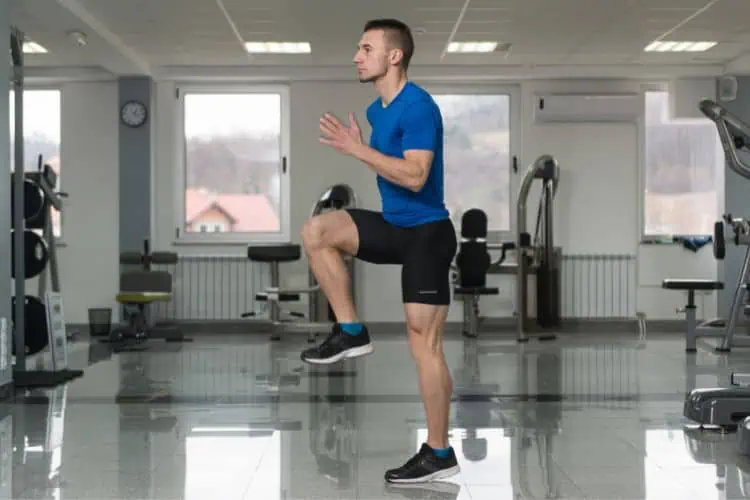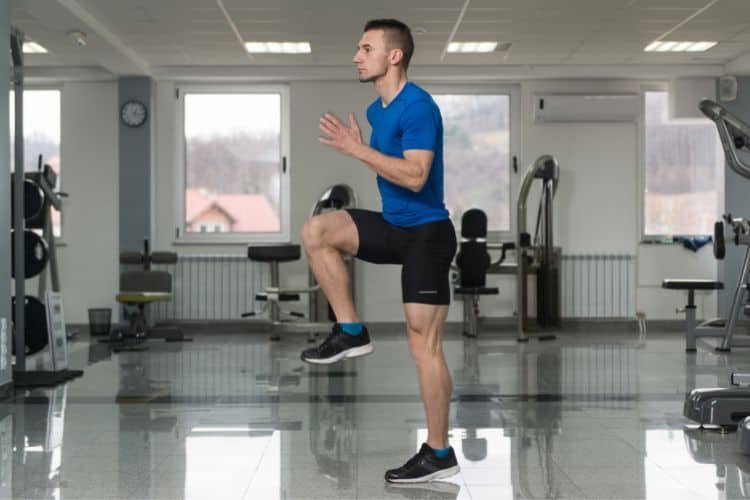
Full body circuit training is a type of training that combines strength and cardio exercises in a structured sequence. Participants complete a series of exercises targeting different muscle groups with minimal rest in between. This format allows for a high intensity full body workout in a relatively short amount of time. It is flexible, effective and suitable for people of all fitness levels, making it a popular choice for people looking to improve strength, endurance and overall fitness.
Benefits of full body circuit training
Effective workouts
Circuit training is ideal for those with busy schedules. Targeting multiple muscle groups and incorporating cardio, it delivers a complete workout in 30 to 45 minutes.
Improved Cardiovascular Health
Including aerobic exercise in your circuit helps improve heart health and increases endurance. The constant movement and minimal rest periods raise your heart rate, providing an effective cardiovascular workout.
Builds Strength and Muscle
By incorporating resistance exercises, circuit training helps build muscle strength and tone. Whether you use body weight, dumbbells or resistance bands, these exercises effectively challenge your muscles.
Enhances calorie burning
The high-intensity nature of circuit training creates a calorie-burning effect during and after your workout. This phenomenon, known as excess post-exercise oxygen consumption (EPOC), ensures that you will continue to burn calories after your workout.
Flexibility and Variety
Circuit training can easily be adapted to suit individual goals and preferences. You can change exercises, intensities and equipment, ensuring your workout remains engaging and effective.
How to structure a full body circuit workout
To create an effective circuit training session, include exercises that target major muscle groups and alternate between upper body, lower body and core movements. This balance prevents fatigue in a single area while allowing you to maintain tension throughout the workout.
Basic components
- Warm-up: Start with 5-10 minutes of light cardio and dynamic stretching to prepare your body.
- Training: Perform 6-10 exercises in a circuit format. Complete each exercise for a specified time (eg 30-60 seconds) or repetitions (eg 10-15 repetitions).
- Balance: Rest lightly between exercises (10-30 seconds) and rest longer (1-2 minutes) after completing the circuit. Repeat the circuit 2-4 times.
- Cool: Finish with stretching and breathing exercises to relax your muscles and prevent stiffness.
Full body workouts
Full body circuit for beginners
This workout is perfect for those new to circuit training. It focuses on fundamental movements and can be done with minimal equipment.
- Bodyweight squats – 15 repetitions
- Push-Ups (modified if needed) – 10-12 reps
- Plank – Hold for 20 seconds
- Lunges (alternate legs) – 10 reps per leg
- Bent rows (using resistance bands or light dumbbells) – 12 reps
- Jumping Jacks – 30 seconds
Repeat the circuit 2-3 times.
Intermediate full body circuit
This workout increases the intensity and incorporates more challenging exercises.
- Cup squats (holding dumbbell or kettlebell) – 12 reps
- Push-ups with shoulders – 10-12 repetitions
- Climbers – 30 seconds
- Romanian Deadlifts (using dumbbells) – 12 reps
- Renegade Rows – 10 repetitions per arm
- Burpees – 10 repetitions
Repeat the circuit 3-4 times.
Advanced full body circuit
This high-intensity circuit is designed for experienced fitness enthusiasts.
- Deadlifts (heavy or heavy dumbbells) – 10 reps
- Pulls or Assisted pull-up – 8-10 reps
- Jump Squats – 12 repetitions
- Push-Up to Pike Push-Up – 10 repetitions
- One-legged Romanian deadlifts (each leg) – 10 reps
- Kettlebell swings – 20 repetitions
- Box Jumps – 10 repetitions
Repeat the circuit 4-5 times.
Equipment options for circuit training
Body weight
Bodyweight exercises like squats, push-ups and planks are accessible and effective. They require no equipment, making them ideal for home workouts.
Dumbbells and Kettlebells
These tools add resistance, enhancing strength-building exercises. Dumbbells are versatile for rows, presses and lunges, while kettlebells are great for swings and lunges.
Resistance bands
Resistance bands are lightweight, portable and great for strength training. They are especially useful for rows, glute bridges and side walks.
Cardiovascular exercise equipment
Incorporating jump ropes, stationary bikes or treadmills can elevate the cardiovascular component of your circuit.
Tips for success
Maintain proper form
Make sure you perform each exercise with proper form to maximize the benefits and reduce the risk of injury. Slow down or modify movements if needed.
Progress Gradually
Increase the intensity by adding resistance, reps or circuit rounds as your fitness improves.
Listen to your body
Pay attention to how you feel during and after your workout. Rest when needed and adjust exercises to avoid overtraining.
Stay Consistent
Aim to circuit train 2-4 times per week, depending on your fitness goals and schedule.
Incorporating circuit training into your fitness routine
Circuit training can complement other fitness activities such as running, yoga or traditional weight lifting. Here are some ideas:
- As a basic workout: Focus on full body circuits 3 times a week for total fitness.
- Additional Education: Use circuits on non-lifting days for active recovery.
- HIIT Sessions: Combine circuits with high-intensity interval training for a fat-burning workout.
Security issues
- Consult a health professional if you have underlying conditions or are new to exercise.
- Warm up well to avoid injury.
- Use the proper equipment and make sure your training area is safe.
- Stay hydrated and listen to your body’s signals.
Final Thoughts
Full body circuit training is a great way to achieve a balanced, effective workout that targets strength, endurance and cardiovascular fitness. With their flexibility and efficiency, they are ideal for anyone who wants to maximize results in a limited amount of time. Start with a beginner routine and gradually progress to more advanced tracks as your fitness improves. Remember, consistency and proper form are key to reaping the full benefits of circuit training.
